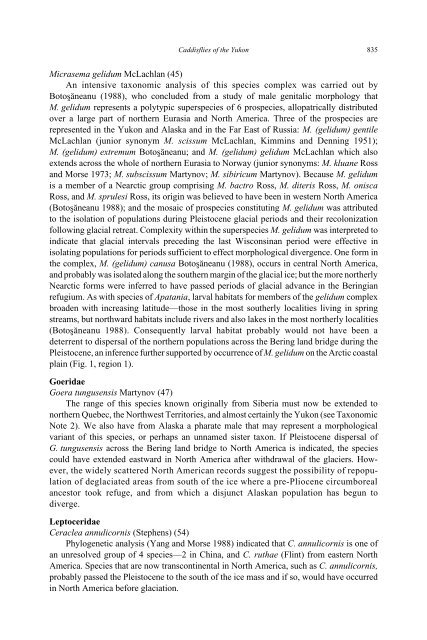Caddisflies of the Yukon - Department of Biological Sciences ...
Caddisflies of the Yukon - Department of Biological Sciences ...
Caddisflies of the Yukon - Department of Biological Sciences ...
Create successful ePaper yourself
Turn your PDF publications into a flip-book with our unique Google optimized e-Paper software.
<strong>Caddisflies</strong> <strong>of</strong> <strong>the</strong> <strong>Yukon</strong> 835<br />
Micrasema gelidum McLachlan (45)<br />
An intensive taxonomic analysis <strong>of</strong> this species complex was carried out by<br />
BotojAneanu (1988), who concluded from a study <strong>of</strong> male genitalic morphology that<br />
M. gelidum represents a polytypic superspecies <strong>of</strong> 6 prospecies, allopatrically distributed<br />
over a large part <strong>of</strong> nor<strong>the</strong>rn Eurasia and North America. Three <strong>of</strong> <strong>the</strong> prospecies are<br />
represented in <strong>the</strong> <strong>Yukon</strong> and Alaska and in <strong>the</strong> Far East <strong>of</strong> Russia: M. (gelidum) gentile<br />
McLachlan (junior synonym M. scissum McLachlan, Kimmins and Denning 1951);<br />
M. (gelidum) extremum BotojAneanu; and M. (gelidum) gelidum McLachlan which also<br />
extends across <strong>the</strong> whole <strong>of</strong> nor<strong>the</strong>rn Eurasia to Norway (junior synonyms: M. kluane Ross<br />
and Morse 1973; M. subscissum Martynov; M. sibiricum Martynov). Because M. gelidum<br />
is a member <strong>of</strong> a Nearctic group comprising M. bactro Ross, M. diteris Ross, M. onisca<br />
Ross, and M. sprulesi Ross, its origin was believed to have been in western North America<br />
(BotojAneanu 1988); and <strong>the</strong> mosaic <strong>of</strong> prospecies constituting M. gelidum was attributed<br />
to <strong>the</strong> isolation <strong>of</strong> populations during Pleistocene glacial periods and <strong>the</strong>ir recolonization<br />
following glacial retreat. Complexity within <strong>the</strong> superspecies M. gelidum was interpreted to<br />
indicate that glacial intervals preceding <strong>the</strong> last Wisconsinan period were effective in<br />
isolating populations for periods sufficient to effect morphological divergence. One form in<br />
<strong>the</strong> complex, M. (gelidum) canusa BotojAneanu (1988), occurs in central North America,<br />
and probably was isolated along <strong>the</strong> sou<strong>the</strong>rn margin <strong>of</strong> <strong>the</strong> glacial ice; but <strong>the</strong> more nor<strong>the</strong>rly<br />
Nearctic forms were inferred to have passed periods <strong>of</strong> glacial advance in <strong>the</strong> Beringian<br />
refugium. As with species <strong>of</strong> Apatania, larval habitats for members <strong>of</strong> <strong>the</strong> gelidum complex<br />
broaden with increasing latitude—those in <strong>the</strong> most sou<strong>the</strong>rly localities living in spring<br />
streams, but northward habitats include rivers and also lakes in <strong>the</strong> most nor<strong>the</strong>rly localities<br />
(BotojAneanu 1988). Consequently larval habitat probably would not have been a<br />
deterrent to dispersal <strong>of</strong> <strong>the</strong> nor<strong>the</strong>rn populations across <strong>the</strong> Bering land bridge during <strong>the</strong><br />
Pleistocene, an inference fur<strong>the</strong>r supported by occurrence <strong>of</strong> M. gelidum on <strong>the</strong> Arctic coastal<br />
plain (Fig. 1, region 1).<br />
Goeridae<br />
Goera tungusensis Martynov (47)<br />
The range <strong>of</strong> this species known originally from Siberia must now be extended to<br />
nor<strong>the</strong>rn Quebec, <strong>the</strong> Northwest Territories, and almost certainly <strong>the</strong> <strong>Yukon</strong> (see Taxonomic<br />
Note 2). We also have from Alaska a pharate male that may represent a morphological<br />
variant <strong>of</strong> this species, or perhaps an unnamed sister taxon. If Pleistocene dispersal <strong>of</strong><br />
G. tungusensis across <strong>the</strong> Bering land bridge to North America is indicated, <strong>the</strong> species<br />
could have extended eastward in North America after withdrawal <strong>of</strong> <strong>the</strong> glaciers. However,<br />
<strong>the</strong> widely scattered North American records suggest <strong>the</strong> possibility <strong>of</strong> repopulation<br />
<strong>of</strong> deglaciated areas from south <strong>of</strong> <strong>the</strong> ice where a pre-Pliocene circumboreal<br />
ancestor took refuge, and from which a disjunct Alaskan population has begun to<br />
diverge.<br />
Leptoceridae<br />
Ceraclea annulicornis (Stephens) (54)<br />
Phylogenetic analysis (Yang and Morse 1988) indicated that C. annulicornis is one <strong>of</strong><br />
an unresolved group <strong>of</strong> 4 species—2 in China, and C. ruthae (Flint) from eastern North<br />
America. Species that are now transcontinental in North America, such as C. annulicornis,<br />
probably passed <strong>the</strong> Pleistocene to <strong>the</strong> south <strong>of</strong> <strong>the</strong> ice mass and if so, would have occurred<br />
in North America before glaciation.
















